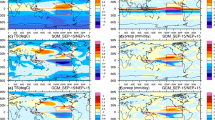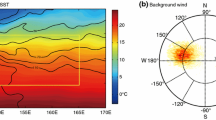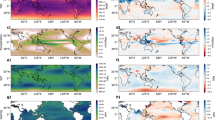Abstract
During austral summer, the majority of precipitation over the Pacific Ocean is concentrated in the South Pacific Convergence Zone (SPCZ). The surface boundary conditions required to support the diagonally (northwest–southeast) oriented SPCZ are determined through a series of experiments with an atmospheric general circulation model. Continental configuration and orography do not have a significant influence on SPCZ orientation and strength. The key necessary boundary condition is the zonally asymmetric component of the sea surface temperature (SST) distribution. This leads to a strong subtropical anticyclone over the southeast Pacific that, on its western flank, transports warm moist air from the equator into the SPCZ region. This moisture then intensifies (diagonal) bands of convection that are initiated by regions of ascent and reduced static stability ahead of the cyclonic vorticity in Rossby waves that are refracted toward the westerly duct over the equatorial Pacific. The climatological SPCZ is comprised of the superposition of these diagonal bands of convection. When the zonally asymmetric SST component is reduced or removed, the subtropical anticyclone and its associated moisture source is weakened. Despite the presence of Rossby waves, significant moist convection is no longer triggered; the SPCZ disappears. The diagonal SPCZ is robust to large changes (up to ±6 °C) in absolute SST (i.e. where the SST asymmetry is preserved). Extreme cooling (change <−6 °C) results in a weaker and more zonal SPCZ, due to decreasing atmospheric temperature, moisture content and convective available potential energy.













Similar content being viewed by others
Notes
Models included: ACCESS1.0, ACCESS1.3, BCC-CSM1.1, BCC-CSM1.1-m, BNU-ESM, CanCM4, CCSM4, CESM1(CAM5), CMCC-CM, CNRM-CM5, CSIRO-Mk3.6.0, FGOALS-g2, GFDL-CM3, GISS-E2-R, HadGEM2-AO, IPSL-CM5A-LR, IPSL-CM5A-MR, IPSL-CM5B-LR, MIROC5, MPI-ESM-LR, MPI-ESM-MR, MRI-CGCM3, NorESM1-M. Details of the CMIP5 experimental setup and model configurations, model physics and references can be found at http://cmip-pcmdi.llnl.gov/cmip5/. November to April time means are based on simulated data from 1979 to 2005.
References
Bagnato S, Linsley BK, Howe SS, Wellington GM, Salinger J (2005) Coral oxygen isotope records of interdecadal climate variations in the South Pacific Convergence Zone region. Geochem Geophys Geosyst 6(Q06):001. doi:10.1029/2004GC000879
Betts AK (1986) A new convective adjustment scheme. Part I: observational and theoretical basis. Q J R Meteorol Soc 112:677–691. doi:10.1002/qj.49711247307
Borlace S, Santoso A, Cai W, Collins M (2014) Extreme swings of the South Pacific Convergence Zone and the different types of El Niño events. Geophys Res Lett 41:4695–4703. doi:10.1002/2014GL060551
Brierley CM, Fedorov AV (2010) Relative importance of meridional and zonal sea surface temperature gradients for the onset of the ice ages and Pliocene-Pleistocene climate evolution. Paleoceanography 25:PA2214. doi:10.1029/2009PA001809
Brown JR, Power SB, Delage FP, Colman RA, Moise AF, Murphy BF (2011) Evaluation of the South Pacific Convergence Zone in IPCC AR4 climate model simulations of the twentieth century. J Clim 24:1565–1582. doi:10.1175/2010JCLI3942.1
Brown JR, Moise AF, Delage FP (2012) Changes in the South Pacific Convergence Zone in IPCC AR4 future climate projections. Clim Dyn 39:1–19. doi:10.1007/s00382-011-1192-0
Brown JR, Moise AF, Colman RA (2013) The South Pacific Convergence Zone in CMIP5 simulations of historical and future climate. Clim Dyn 41:2179–2197. doi:10.1007/s00382-012-1591-x
Cai W, Lengaigne M, Borlace S, Collins M, Cowan T, McPhaden MJ, Timmermann A, Power S, Brown J, Menkes C, Ngari A, Vincent EM, Widlansky MJ (2012) More extreme swings of the South Pacific Convergence Zone due to greenhouse warming. Nature 488:365–370. doi:10.1038/nature11358
Folland CK, Renwick JA, Salinger MJ, Mullan AB (2002) Relative influences of the Interdecadal Pacific Oscillation and ENSO on the South Pacific Convergence Zone. Geophys Res Lett 29:1643. doi:10.1029/2001GL014201
Forster PMdF, Blackburn M, Glover R, Shine KP (2000) An examination of climate sensitivity for idealised climate change experiments in an intermediate general circulation model. Clim Dyn 16:833–849. doi:10.1007/s003820000083
Haffke C, Magnusdottir G (2013) The South Pacific Convergence Zone in three decades of satellite images. J Geophys Res 118:1–11. doi:10.1002/jgrd.50838
Held IM, Soden BJ (2006) Robust responses of the hydrological cycle to global warming. J Clim 19:5686–5699. doi:10.1175/JCLI3990.1
Joshi MM, Stringer M, Van der Wiel K, O’Callaghan A, Fueglistaler S (2015) IGCM4: a fast, parallel and flexible intermediate climate model. Geosci Model Dev 8:1157–1167. doi:10.5194/gmd-8-1157-2015
Juillet-Leclerc A, Thiria S, Naveau P, Delcroix T, Le Bec N, Blamart D, Correge T (2006) SPCZ migration and ENSO events during the 20th century as revealed by climate proxies from a Fiji coral. Geophys Res Lett 33. doi:10.1029/2006GL025950
Kiladis GN, von Storch H, van Loon H (1989) Origin of the South Pacific Convergence Zone. J Clim 2:1185–1195. doi:10.1175/1520-0442(1989)002<1185:OOTSPC>2.0.CO;2
Kitoh A (2002) Effects of large-scale mountains on surface climate: a coupled ocean–atmosphere general circulation model study. J Meteorol Soc Jpn 80:1165–1181. doi:10.2151/jmsj.80.1165
Lintner BR, Neelin JD (2008) Eastern margin variability of the South Pacific Convergence Zone. Geophys Res Lett 35(L16):701. doi:10.1029/2008GL034298
Matthews AJ (2012) A multiscale framework for the origin and variability of the South Pacific Convergence Zone. Q J R Meteorol Soc 138:1165–1178. doi:10.1002/qj.1870
McClymont EL, Rosell-Mele A (2005) Links between the onset of modern walker circulation and the mid-Pleistocene climate transition. Geology 33:389–392. doi:10.1130/G21292.1
Nieto Ferreira R, Chao WC (2013) Aqua-planet simulations of the formation of the South Atlantic convergence zone. Int J Climatol 33:615–628. doi:10.1002/joc.3457
Niznik MJ, Lintner BR (2013) Circulation, moisture and precipitation relationships along the South Pacific Convergence Zone in reanalyses and CMIP5 models. J Clim 26:10,174–10,192. doi:10.1175/JCLI-D-13-00263.1
Niznik MJ, Lintner BR, Matthews AJ, Widlansky MJ (2015) The role of tropical–extratropical interaction and synoptic variability in maintaining the South Pacific Convergence Zone in CMIP5 models. J Clim 28:3353–3374. doi:10.1175/JCLI-D-14-00527.1
Reynolds RW, Rayner NA, Smith TM, Stokes DC, Wang W (2002) An improved in situ and satellite SST analysis for climate. J Clim 15:1609–1625. doi:10.1175/1520-0442(2002)015<1609:AIISAS>2.0.CO;2
Riemann-Campe K, Fraedrich K, Lunkeit F (2009) Global climatology of convective available potential energy (CAPE) and convective inhibition (CIN) in ERA-40 reanalysis. Atmos Res 93:534–545. doi:10.1016/j.atmosres.2008.09.037
Saint-Lu M, Braconnet P, Leloup J, Lengaigne M, Marti O (2015) Changes in the ENSO/SPCZ relationship from past to future climates. Earth Planet Sci Lett 412:18–24. doi:10.1016/j.epsl.2014.12.033
Seager R, Murtugudde R (1997) Ocean dynamics, thermocline adjustment, and regulation of tropical SST. J Clim 10:521–534. doi:10.1175/1520-0442(1997)010<0521:ODTAAR>2.0.CO;2
Slingo JM (1987) The development and verification of a cloud prediction scheme for the ECMWF model. Q J R Meteorol Soc 113:899–927. doi:10.1002/qj.49711347710
Streten NA (1973) Some characteristics of satellite-observed bands of persistent cloudiness over the Southern Hemisphere. Mon Weather Rev 101:486–495. doi:10.1175/1520-0493(1973)101<0486:SCOSBO>2.3.CO;2
Takahashi K, Battisti DS (2007a) Processes controlling the mean tropical Pacific precipitation pattern. Part I: the Andes and the Eastern Pacific ITCZ. J Clim 20:3434–3451. doi:10.1175/JCLI4198.1
Takahashi K, Battisti DS (2007b) Processes controlling the mean tropical Pacific precipitation pattern. Part II: the SPCZ and the southeast Pacific dry zone. J Clim 20:5696–5706. doi:10.1175/2007JCLI1656.1
Trenberth KE (1976) Spatial and temporal variations of the Southern Oscillation. Q J R Meteorol Soc 102:639–653. doi:10.1002/qj.49710243310
Van der Wiel K, Matthews AJ, Stevens DP, Joshi MM (2015) A dynamical framework for the origin of the diagonal South Pacific and South Atlantic Convergence Zones. Q J R Meteorol Soc. doi:10.1002/qj.2508
Vincent DG (1994) The South Pacific Convergence Zone (SPCZ): a review. Mon Weather Rev 122:1949–1970. doi:10.1175/1520-0493(1994)122<1949:TSPCZA>2.0.CO;2
Vincent EM, Lengaigne M, Menkes CE, Jourdain NC, Marchesiello P, Madec G (2011) Interannual variability of the South Pacific Convergence Zone and implications for tropical cyclone genesis. Clim Dyn 36:1881–1896. doi:10.1007/s00382-009-0716-3
Widlansky MJ, Webster PJ, Hoyos CD (2011) On the location and orientation of the South Pacific Convergence Zone. Clim Dyn 36:561–578. doi:10.1007/s00382-010-0871-6
Widlansky MJ, Timmermann A, Stein K, McGregor S, Schneider N, England MH, Lengaigne M, Cai W (2013) Changes in South Pacific rainfall bands in a warming climate. Nat Clim Change 3:417–423. doi:10.1038/nclimate1726
Xie P, Arkin PA (1997) Global precipitation: a 17-year monthly analysis based on gauge observations, satellite estimates, and numerical model outputs. Bull Am Meteorol Soc 78:2539–2558. doi:10.1175/1520-0477(1997)078<2539:GPAYMA>2.0.CO;2
Zhong WY, Haigh JD (1995) Improved broad-band emissivity parameterization for water vapor cooling calculations. J Atmos Sci 52:124–138. doi:10.1175/1520-0469(1995)052<0124:IBEPFW>2.0.CO;2
Acknowledgments
The CMAP and NOAA IO V2 data were provided by the NOAA/OAR/ESRL PSD, Boulder, Colorado, USA, from their web site at http://www.cdc.noaa.gov/. We acknowledge the World Climate Research Programme’s Working Group on Coupled Modelling, which is responsible for CMIP, and we thank the climate modelling groups for producing and making available their model output. The CMIP5 data was downladed from http://cmip-pcmdi.llnl.gov/cmip5/. The research presented in this article was carried out on the High Performance Computing Cluster supported by the Research Computing Service at the University of East Anglia. The authors would like to thank two anonymous reviewers for comments which helped to improve the manuscript.
Author information
Authors and Affiliations
Corresponding author
Rights and permissions
About this article
Cite this article
van der Wiel, K., Matthews, A.J., Joshi, M.M. et al. Why the South Pacific Convergence Zone is diagonal. Clim Dyn 46, 1683–1698 (2016). https://doi.org/10.1007/s00382-015-2668-0
Received:
Accepted:
Published:
Issue Date:
DOI: https://doi.org/10.1007/s00382-015-2668-0




